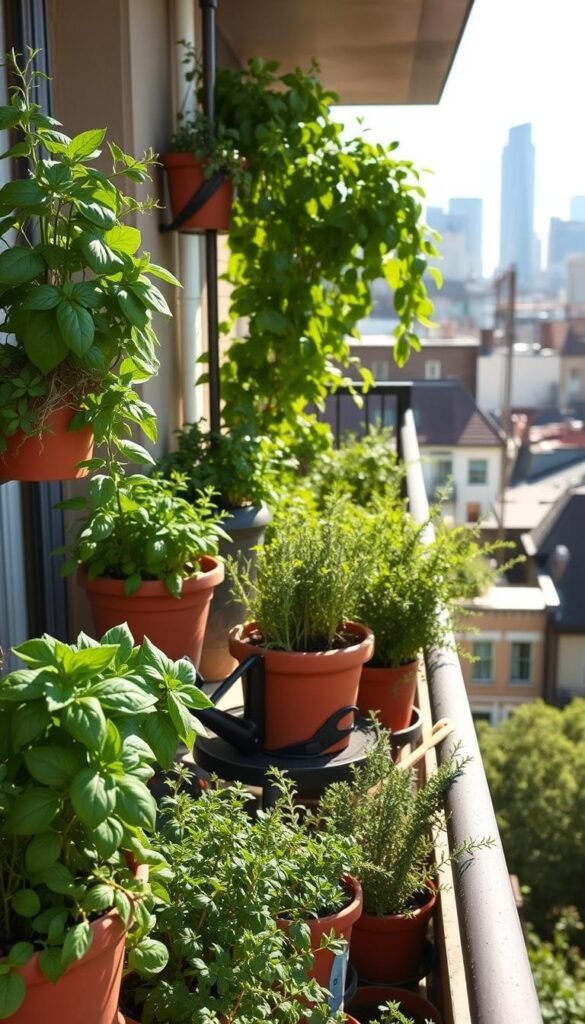Imagine stepping outside your door to snip fresh rosemary for tonight’s roasted vegetables or pluck peppery perilla leaves to preserve in soy sauce. Small outdoor spaces can become lush, productive areas with the right approach. Whether you’re in a high-rise apartment or a cozy townhouse, transforming your balcony into a garden is simpler than you think.
Many city dwellers find joy in nurturing plants like thyme, sage, or mint—herbs that thrive in pots with minimal effort. One gardener even turned a 4-foot space into a perilla paradise, learning to pickle leaves for year-round use. That’s the magic of working with nature: even tiny corners can yield big flavors.
You don’t need a backyard to enjoy homegrown ingredients. Container setups let you control soil quality and sunlight, making it easier to avoid chemicals. Picture adding just-picked basil to your pasta or garnishing cocktails with homegrown mint. Every harvest feels like a mini victory, connecting you to your meals in ways store-bought greens never could.
This guide will show you how to start, maintain, and love your compact green haven. Let’s dig into the dirt-free details!
Understanding Urban Gardening on Balconies: Grow Organic Herbs and Produce in Containers
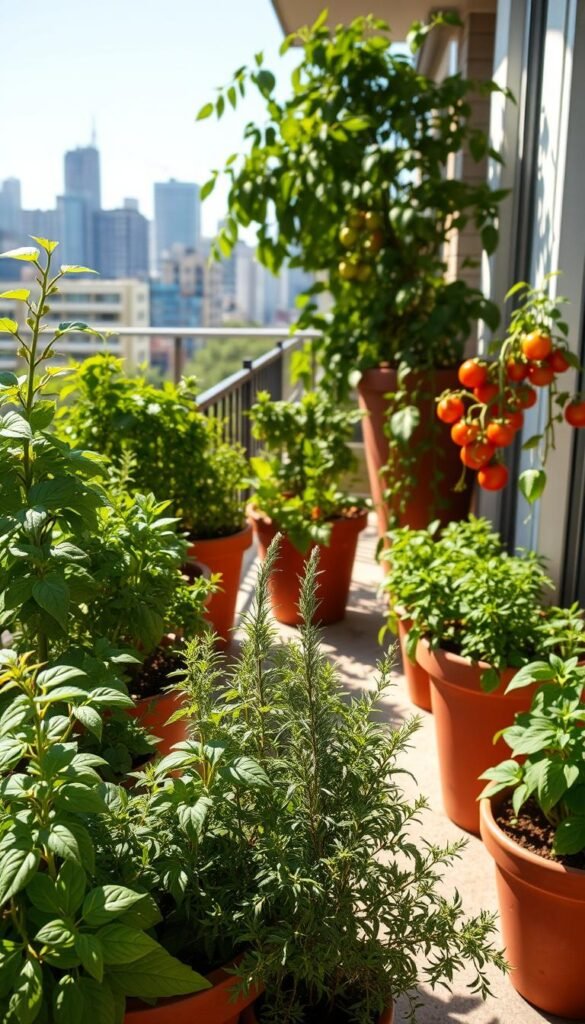
Picture this: a vibrant mix of basil, parsley, and mint growing steps from your kitchen. Container setups turn concrete spaces into edible landscapes. They let you grow food where traditional plots can’t thrive.
Smart Growing in Small Spaces
Potted plants give you command over soil quality and sunlight exposure. You decide what goes into your food – no mystery chemicals. Studies show homegrown greens pack more nutrients than store-bought alternatives.
Balcony edges make perfect plant perches. They catch sunlight while staying protected from harsh winds. Rail planters maximize vertical space, letting you grow upwards instead of outwards.
Nature’s Stress Relief System
Tending plants reduces cortisol levels by 14%, according to recent research. Your green corner becomes a calming retreat from city noise. Even five minutes daily with your no-fail herbs can boost mood and focus.
| Benefit | Container Setup | Traditional Garden |
|---|---|---|
| Space Needed | 1-10 sq ft | 50+ sq ft |
| Startup Cost | $20-$100 | $500+ |
| Pest Control | Easier | Complex |
| Harvest Speed | 2-4 weeks | 6-8 weeks |
Seasonal changes? No problem. Move pots indoors when frost threatens. Rotate sun-loving plants with shade-tolerant varieties as light patterns shift. Your garden adapts as needed.
This approach builds skills that scale. Master basil in a pot today, try dwarf tomatoes tomorrow. Every harvest teaches you more about nature’s rhythms – right outside your door.
Selecting the Right Containers for Your Organic Garden
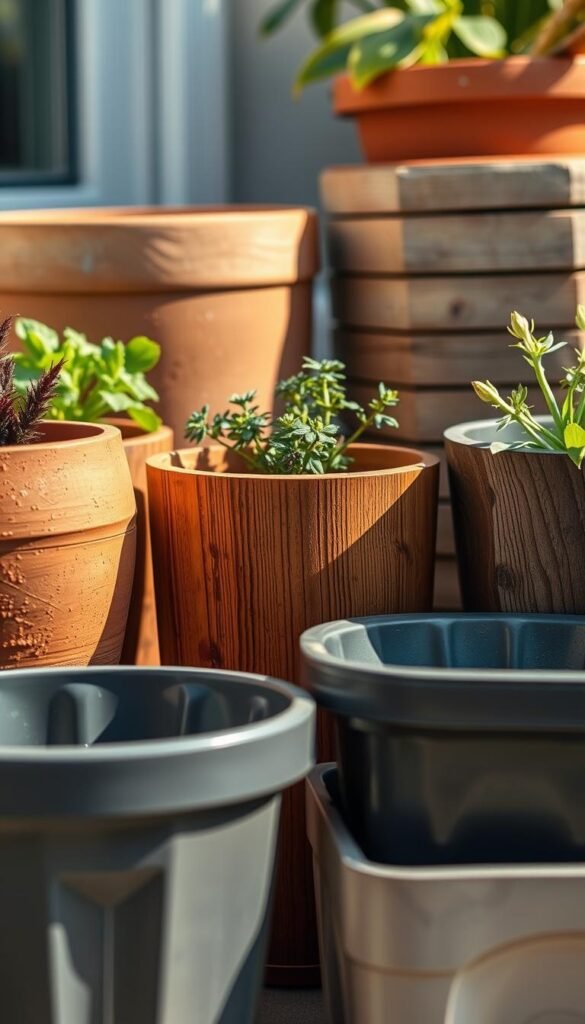
Your container choice can make or break your green oasis. While almost any sturdy object with drainage holes works, smart selections prevent root stress and boost yields. Let’s explore what turns ordinary pots into powerhouse growing spaces.
Material Options and Their Pros & Cons
Breathable terracotta cools roots naturally but dries out fast – perfect for Mediterranean herbs like rosemary. Glazed ceramics retain water better but limit airflow. Plastic containers stay moist longer but may overheat; light-colored options reflect sunlight better.
- Unglazed clay: Excellent drainage, needs frequent watering
- Recycled plastic: Lightweight, budget-friendly, check for food-safe labels
- Fabric pots: Air-prunes roots, prevents overwatering
Ensuring Adequate Drainage
Roots drown without oxygen. Always use pots with multiple holes – drill extras if needed. Elevate containers on feet or stones for better airflow. Pair with trays to protect surfaces while letting excess water escape.
Bigger container sizes (12″+ depth) give roots room to stretch. For space-efficient vegetables, choose 5-gallon buckets or window boxes. Repurpose food-grade barrels or wooden crates for organic container setups – just line with landscape fabric first.
Remember: Dark soil heats up faster. Light-colored containers help regulate temperature. Match your pot material to your plants’ needs, and you’ll see the difference in every harvest.
Essential Tools and Supplies for Container Gardening
Think of your containers as mini ecosystems – their success starts with what you put inside them. Quality materials and smart prep work turn cramped quarters into thriving plant homes. Let’s unpack the must-haves that’ll keep your green friends happy from roots to leaves.
Choosing High-Quality Potting Mix and Compost
Store-bought soil saves time, but not all bags are equal. Look for the OMRI Listed seal – it’s your guarantee against hidden chemicals. Premium potting mix breathes better than garden dirt, preventing soggy roots.
Boost basic blends by mixing in 1/3 compost. Worm castings work wonders – they hold moisture like a sponge while feeding plants. For extra nutrition, add a handful of volcanic rock dust and a sprinkle of lime. These tweaks balance pH and add minerals your crops crave.
Investing in Basic Gardening Tools
A narrow trowel becomes your best friend for repotting basil. Sharp shears make clean cuts that heal faster. Choose a watering can with a long spout to reach back-row plants without spilling.
Three essentials cover most tasks:
- Stainless steel hand rake for mixing soil
- Moisture meter to prevent overwatering
- Pruner with spring-action handles
Pair these with organic liquid fertilizer every two weeks. Your setup stays simple, but your harvests? They’ll taste anything but basic.
Choosing Your Herbs, Vegetables, and Flowers
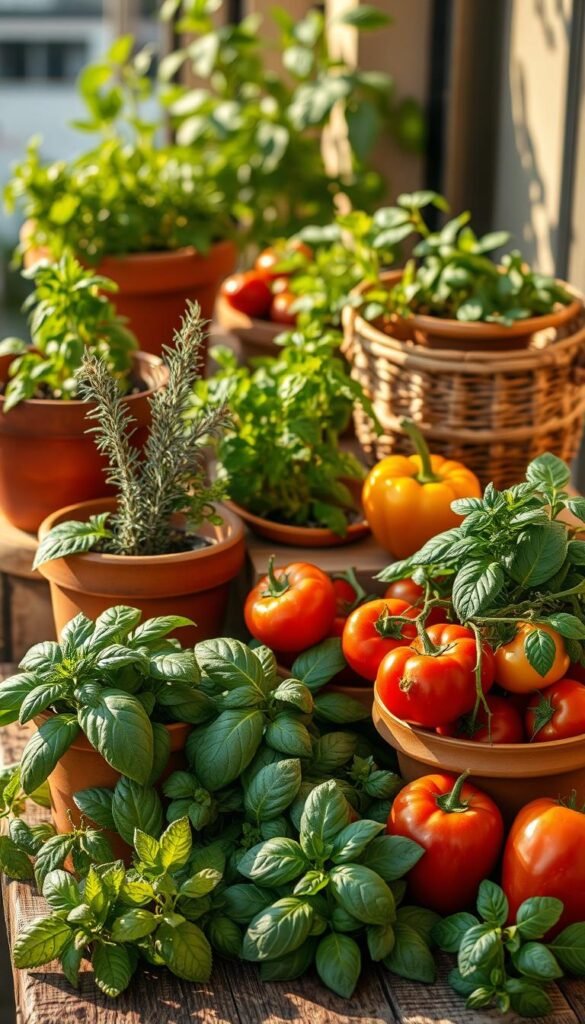
Your plant picks determine your balcony’s bounty. Start with reliable performers that match your space and sunlight, then experiment with colorful accents. The right mix turns concrete corners into edible art.
Herbs That Thrive on Balconies
Thyme and rosemary laugh at neglect – water them weekly, and they’ll flavor roasts for months. Mint spreads faster than city gossip, so keep it solo in its pot. Sage’s fuzzy leaves handle afternoon shade, while basil demands sunbathing time.
Snip basil stems above leaf nodes for nonstop production. One plant can sauce six pasta dinners! For Asian dishes, try perilla – its burgundy leaves pickle beautifully.
Vegetables and Edibles for Limited Spaces
Dwarf cherry tomatoes like ‘Tiny Tim’ fruit heavily in 12″ pots. Chili peppers thrive in heat – place them against sun-warmed walls. Lettuce grows vertically in stacked planters, yielding salads weekly.
Sow cilantro every three weeks for constant harvests. When leaves bolt, collect seeds as coriander. Pair these with nasturtiums – their peppery blooms dress plates and attract pollinators.
| Plant Type | Sun Needs | Container Size |
|---|---|---|
| Basil | 6-8 hours | 8-10″ deep |
| Lettuce | 3-4 hours | 6″ shallow |
| Chili peppers | Full sun | 5-gallon bucket |
Optimizing Space and Sunlight Exposure on Your Balcony
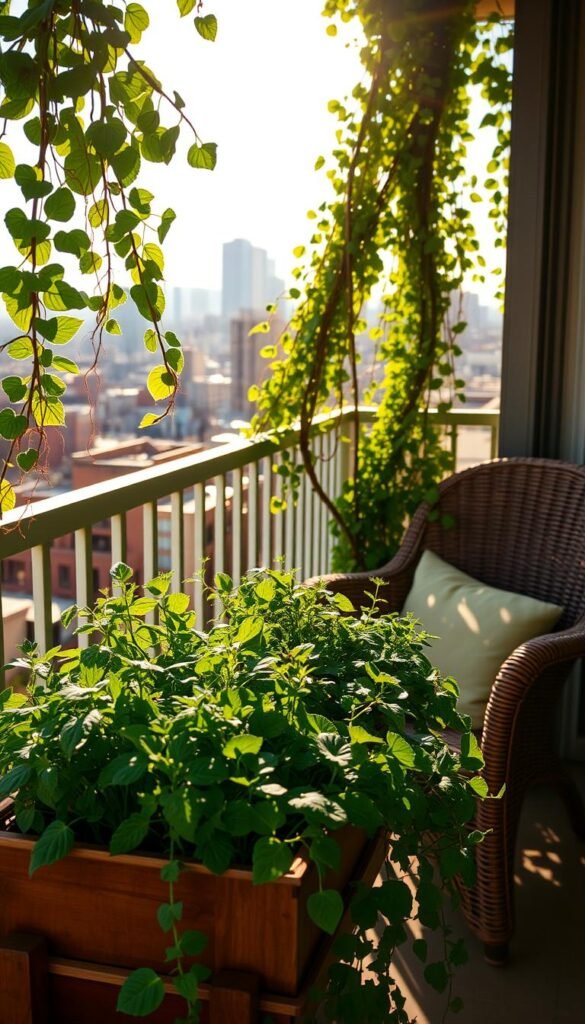
How much sun does your space really get? Start by mapping light patterns with a simple trick: mark hourly shadows using chalk. Sun-loving tomatoes need 6-8 hours of direct rays, while leafy greens thrive with just 3-4. This detective work reveals your balcony’s hidden potential.
Smart Layouts for Maximum Growth
Vertical planters triple your planting real estate without crowding walkways. Install wall-mounted systems for strawberries or trailing nasturtiums. Tiered stands let shorter herbs like thyme bask below taller pepper plants. Always leave 12″ between containers for airflow – crowded roots invite disease.
Weight matters more than you think. A 5-gallon pot weighs 40+ pounds when wet. Distribute heavy planters near load-bearing walls, and use lightweight fabric pots for railings. Check your building’s weight limits – safety first!
Position water-hungry shade-tolerant herbs near your hose connection. Create microclimates by placing heat-loving chilies against reflective walls. Rotate pots weekly so all sides get equal sun exposure. Your plants will reward you with bushier growth.
Corner shelves transform dead zones into herb havens. Hang baskets from ceiling hooks for trailing oregano or mint. With smart planning, even a 4’x6′ area can yield 20+ edible varieties. Now that’s sunshine put to work!
Creating a Healthy Organic Soil and Fertilizer Plan
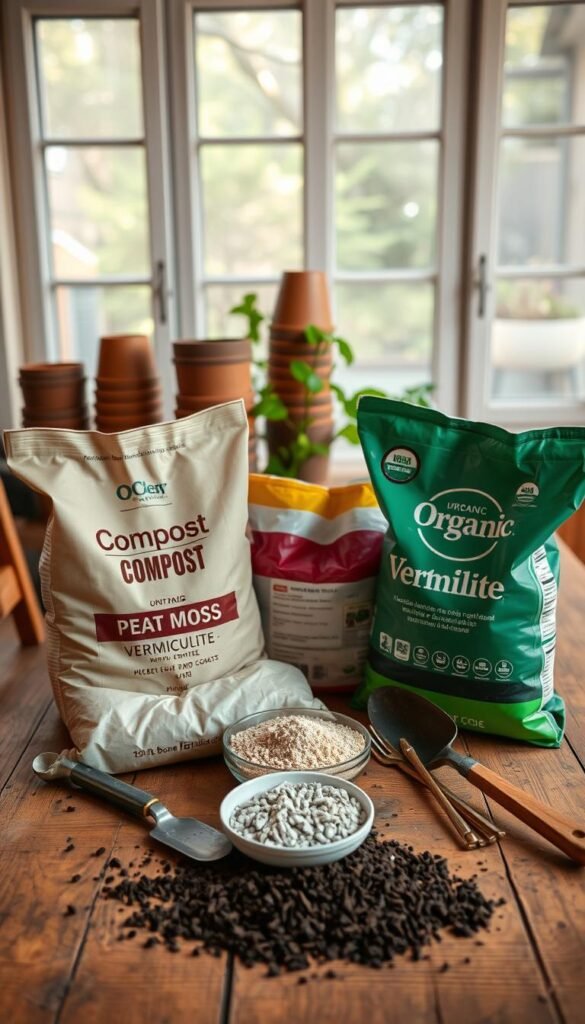
Great soil is the secret sauce for container plants that burst with flavor. Unlike garden beds, potted greens need extra care since watering flushes away nutrients faster. Let’s build a feeding strategy that keeps roots happy from seedling to harvest.
Mixing Your Own Organic Potting Soil
Start with equal parts compost, coconut coir, and perlite. This trio balances moisture retention and airflow. Add worm castings for slow-release nutrients – they’re like vitamins for your plants.
For tomatoes or peppers, mix in crushed eggshells. They add calcium to prevent blossom rot. Always test your soil pH with a $7 kit. Most edibles thrive between 6.0-6.8.
Natural Fertilizers and Amendments
Ocean water concentrates pack 90+ minerals plants adore. Studies show crops grown with sea-based fertilizers develop deeper roots in just 8 weeks. Liquid kelp is easier to use – spray it on leaves every month.
Household items work too:
- Molasses feeds microbes – stir 1 tbsp into a gallon of water
- Used coffee grounds acidify soil for blueberries
- Banana peels buried near roses boost potassium
Rotate fertilizers every 3 weeks. Your plants get balanced health without chemical buildup. Watch those leaves glow!
Container Watering and Irrigation Techniques
Mastering moisture levels transforms your green space from surviving to thriving. Plants in pots need different care than those in ground beds – their roots can’t chase water deep underground. Let’s explore how to quench their thirst without drowning their potential.
Best Practices for Regular Watering
Your finger is the ultimate moisture meter. Push it an inch into the soil – if it feels dry, grab your watering can. Pour slowly until liquid escapes the drainage holes. This ensures roots get a full drink without soggy conditions.
Letting the top layer dry between sessions strengthens plants. It teaches roots to seek deeper moisture, building drought resilience. Overly damp soil invites mold and pests, so balance is key.
Utilizing Drip Irrigation and Self-Watering Options
Busy schedule? Install a drip system with timers. These deliver precise water amounts directly to roots, cutting waste by 50% compared to hand watering. Pair with hydroponic setups for tech-forward growing in tight spaces.
Self-watering containers use reservoirs to maintain consistent moisture. They’re perfect for vacations or heatwaves. Just refill the base every 5-7 days, and your plants stay happily hydrated.
Whether you choose hands-on care or automated solutions, proper hydration turns leaves greener and harvests sweeter. Your balcony oasis will thank you with every juicy tomato and fragrant basil sprig.

